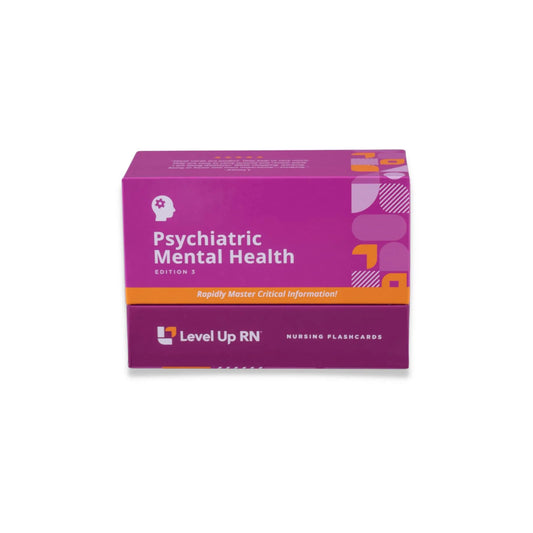Psychiatric Mental Health, part 17: Therapies - Benzodiazepines & Atypical Anxiolytics
Key medications used to treat anxiety, including benzodiazepines (diazepam, lorazepam, midazolam, alprazolam, chlordiazepoxide) and atypical anxiolytics (buspirone). The mode of action, side effects, and important teaching regarding medications in these drug classes.
Full Transcript: Psychiatric Mental Health, part 17: Therapies - Benzodiazepines & Atypical Anxiolytics
Full Transcript: Psychiatric Mental Health, part 17: Therapies - Benzodiazepines & Atypical Anxiolytics
Hi, I'm Cathy with Level Up RN. In this video, we will be discussing key medications that are used in the treatment of anxiety, including benzodiazepines and atypical anxiolytics. At the end of the video, I'm going to give you guys a little quiz to test your knowledge of some of the key points I'll be covering. So definitely stay tuned for that. And if you have our Level Up RN Psychiatric Mental Health Nursing Flashcards, definitely pull those out so you can follow along with me, and pay close attention to the bold red text on these cards because those represent the most important points that you are likely to get tested on on your nursing school exams.
Benzodiazepines include medications such as diazepam, lorazepam, midazolam, alprazolam, as well as chlordiazepoxide. So most medications in this class will end in pam or lam, except for chlordiazepoxide, but chlordiazepoxide has that diaze in the middle of the name to help you remember that it belongs with the other benzodiazepines. Drugs in this class are used to treat anxiety, muscle spasms, seizures, alcohol withdrawal, as well as the induction and maintenance of anesthesia. The mode of action of benzodiazepines is to enhance the effect of GABA in the central nervous system, which has a calming effect. The side effects of benzodiazepines are super important to know, and those include sedation, amnesia, respiratory depression, as well as dependence and withdraw. Because many benzodiazepines end in pam, our cool chicken hint to help you remember this drug class is Pam takes lorazepam for her anxiety. She doesn't drive her Benz anymore because benzos cause sedation. Medications in this drug class should not be discontinued abruptly, and benzodiazepines are intended for short term use only. And last but not least, the antidote for benzodiazepines is flumazenil. So just to be clear, it is not naloxone, which is the antidote for opioid analgesics.
Moving on now to our atypical anxiolytics, the key medication to know in this class is buspirone. And to remember that buspirone is used to treat anxiety, think of taking a bus to a pier and sitting alone, which can help ease your anxiety like buspirone. Unlike benzodiazepines, buspirone does not cause sedation, so it is more appropriate for long-term use. Side effects include nausea, dizziness, and headache. You should teach your patient to take buspirone with the same amount of food each time to prevent a change in absorption level. They should not consume grapefruit juice while taking buspirone, and the full effects of this medication may not be felt for several weeks.
All right, it's quiz time, and I've got three true or false questions for you. Question number one, benzodiazepines enhance the effect of GABA in the central nervous system. True or false? The answer is true. Question number two, naloxone is the antidote for benzodiazepines. True or false? The answer is false. Flumazenil is the antidote for benzodiazepines. Question number three, key side effects of buspirone include respiratory depression, sedation, and amnesia. True or false? The answer is false. Those are the side effects of benzodiazepines. Okay, hope you did great on that quiz, and I hope you found this video to be helpful. Take care and good luck with studying.


